Towards 5G Mobility: The role of efficient discrete semiconductors
This article explains the technical requirements of 5G and describes the new semiconductor components that enable Vehicle-to-Everything connectivity in smart cars.
By Dirk Wittorf, PhD. in Physics at RWTH Aachen University, Senior Director Strategic Marketing Nexperia.
This article is part of a series about semiconductors for ADAS and Autonomous Vehicles. The first article provided an introduction on “How Advanced Driver-Assistance Systems (ADAS) Impact Automotive Semiconductors,” and the second article explained how new semiconductor products can increase reliability and performance as the demands on automotive electronic systems increase.
In this third article, we will look at how another upcoming technological development (5G and smart cars) is impacted by the performance of semiconductor components.
Intro
Communication and connectivity are key elements for the implementation of smart cars and autonomous vehicles. Vehicle-to-Everything (V2X) stands for enabling connected cars and other robotic vehicles to communicate and receive data from external entities. V2X technologies and protocols enable vehicles to interact with other vehicles (V2V), persons (V2P), traffic infrastructure (V2I), and networks (V2N) (also dubbed ‘V2C,’ for ‘Vehicle-to-Cloud’).
As we’ll see in this article, the implementation of V2X technology in vehicles increases the demands on their electronic systems and their semiconductors.
The Current State of V2X
In November 2019, applications of C-V2X (Cellular Vehicle-to-Everything) based on 5G were demonstrated on open city streets and a test track in Turin. 1 Prominent members and partners of the 5G Automotive Association (5GAA) such as Audi, Continental, Ericsson, Fiat Chrysler, Qualcomm, and Vodafone were showcasing road implementation of this technology.
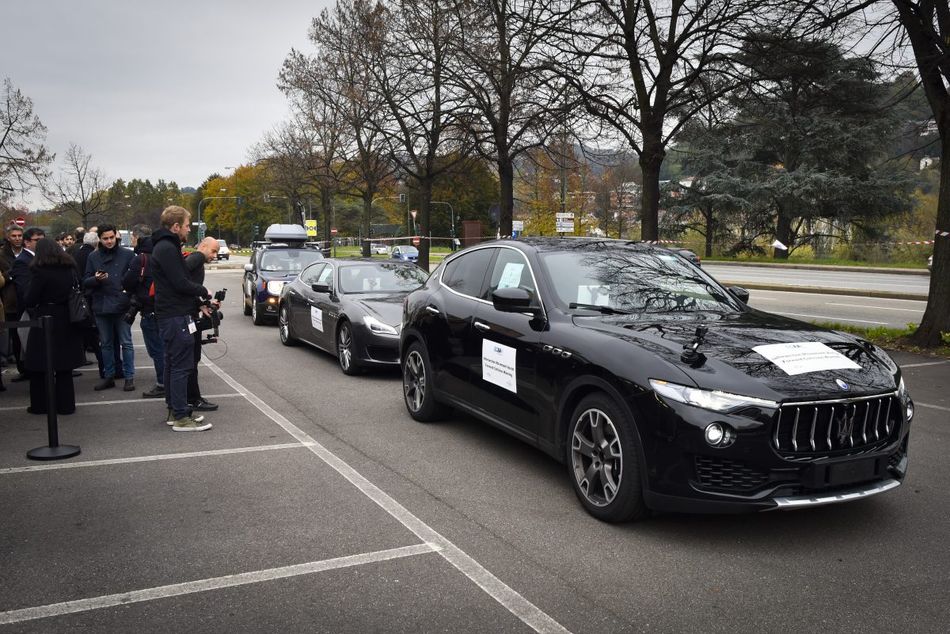
For example, Fiat Chrysler Automobiles, Continental, and Qualcomm partnered to showcase V2V using vehicles that communicated using direct-short range 5G technology. In the case of sudden braking, a message was broadcasted to following vehicles to notify them of the potentially dangerous situation.
Other applications in Turin demonstrated use cases such as:
- Alerting drivers about a crossing pedestrian
- Real time warnings to drivers concerning roadworks
- Preventing incidents at dangerous intersections or in the event of unexpected braking by C-V2V (vehicle to vehicle) communication.1
According to the 5GAA these demos showcase that “connected mobility is a market reality.” In another demo in France on July 27th 2019, by the 5G Communication Automotive Research and innovation (5GCAR) and supported by the EU Commission, 14 European organizations including the PSA group, Bosch, Orange, and Volvo Cars4 showcased 5G V2X operations on a track where both autonomous and non-communicating cars were present.
Partnerships for advancing connected vehicle technology are on the rise. For example, on Dec 19th 2019, Ericsson and Microsoft announced a team up for the next generation of cars. Ericsson is building its Connected Vehicle Cloud on top of the Microsoft Connected Vehicle Platform that is running on the Microsoft Azure cloud platform. Ericsson’s Connected Vehicle Cloud connects already more than 4 million vehicles across 180 countries worldwide which is approximately 10 percent of the connected vehicle market. Through this service, automakers are be able to deploy and scale global vehicle services such as fleet management, over-the-air software updates and connected safety services much faster in a more cost efficient way5.
Another collaboration, between Continental and Vodaphone on “5G ready networks”, highlights three applications of V2X to achieve maximum safety for all road users:
- Overtaking assistance, e.g. when you have no view of what is in front of the car to be overtaken
- Smart traffic jam warning, e.g. approaching a traffic jam in the fog
- Vulnerable road user warning, e.g. cyclist in the blind spot
An example of a smart traffic jam warning is shown in Figure 1. The connected car communicates via the application server and gets in milliseconds latest traffic information.
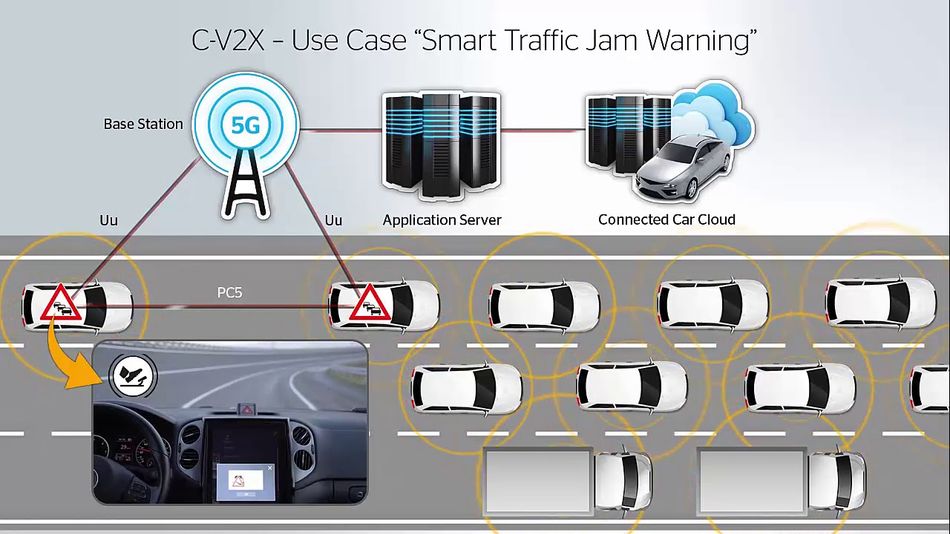
V2X Technology
V2X communication could be done either with:
- Dedicated short-range communication (DSRC), based on the IEEE 802.11p automobile-specific WiFi standard.
- Cellular-V2X, which has two interfaces on two different communication channels:
- Uu radio interface, which is the usual access from the C-V2X module to the mobile network
- PC5, which is similar to DSRC also using 5.9GHz. PC5 (originally defined to address the needs of mission-critical communication for the public safety community) does not require any mobile network to operate between devices.
Different car manufacturers are prioritizing different approaches for V2X. The new Golf model from Volkswagen will be equipped with WiFi technology while BMW, AUDI, PSA and Ford are working on Cellular-V2X compatible equipment.
China has already decided to follow the cellular path with plans to require such an equipment in newly build cars from 2025 onwards2. This stems from China’s existing ambitious investment in 5G connectivity, with renders C-V2X a choice that fits well with existing investments. In 2019, about 130,000 5G base stations were expected to become operation in China are built in 2019, with a projected 460 million 5G users by the end of 20253.
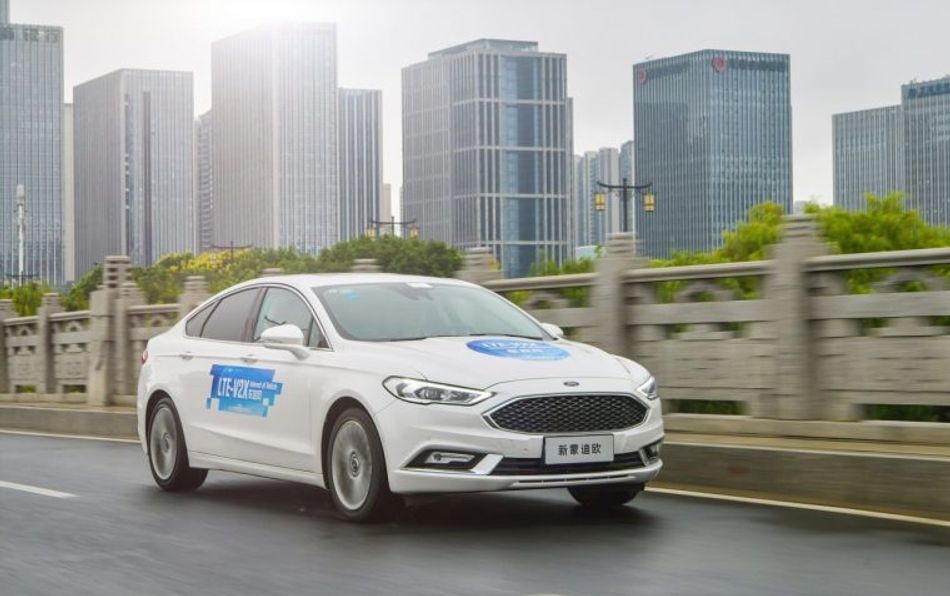
Overall, based on the sheer numbers C-V2X is emerging as the forerunner among the two technologies. This mainly stems from the interest in implementation of 5G cellular technology to enable IoT applications outside of autonomous vehicles.
5G Requirements
The requirements of a 5G network are9,10
- Real data rates of 1 to 10 Gbit/s
- 1ms end-to-end latency
- Ability to support 1000 times the bandwidth of today’s cell phones
- Ability to support 10 to 100 times the number of devices.
- A 99.999% perceived availability and 100% perceived coverage
- Lower power consumption
These requirements will ensure the desired capacity, throughput, low latency, resiliency, reliability and security required for internet-of-things applications, including autonomous vehicles. Ultra-reliability can be quantized as 10-7 package loss probability and ultra-low latency should fulfill an upper bound limit of 1ms on an end-to-end (E2E) basis6.
Towards Smaller, Better Semiconductors Components
As you can see, the significant requirements of 5G technology put higher demands on vehicle’s electronic systems. Examples of 5G wireless Car Modules are the “Huawei MH5000 5G Car Module”, or the V2X module from Continental as shown in Figure 2. Those modules are flat and small to get them conveniently integrated into the car design.
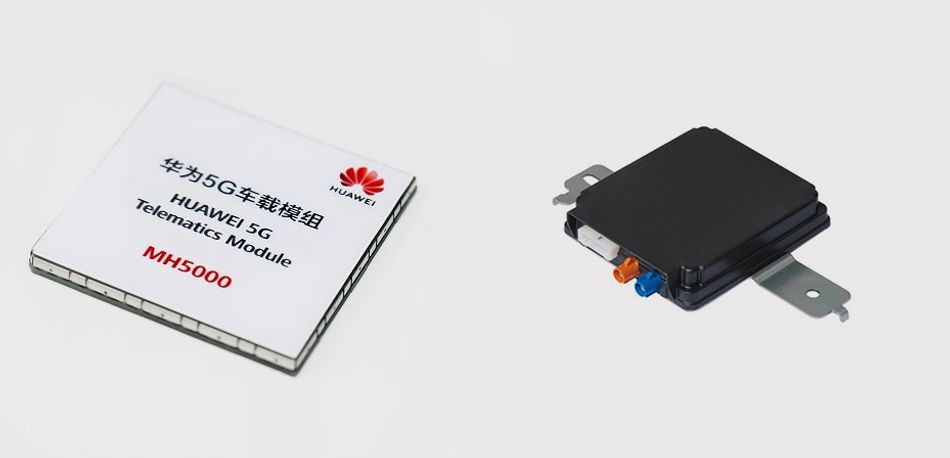
In addition to size, shape and power consumption of the V2X module, another consideration is the quality of any semiconductor device to be integrated in those 5G V2X modules: Automotive qualification and packages suitable for automatic optical inspection are required. Furthermore, manufacturers need proof points for delivering high quality in high volumes as this 5G application is to be expected to grow steeply.
All these communication modules are based on a series of logic circuits implemented through semiconductor technology. In essence, semiconductor components are categorized based on their degree of integration. At the lowest integration level lie discrete semiconductor components such as transistors or diodes which perform a single function. Integrating multiple discrete semiconductor devices into a component, we arrive at integrated circuits (ICs) which have multiple electronic circuits (and hence functions) on a single chip. Very large-scale integration (VLSI) are ICs by combining millions of transistors.
As ICs rely on discrete components, advances at the level of discrete semiconductors (be it in size, power consumption or performance) around those ICs have the potential to significantly improve the performance of the electronic circuit.
The space constraints for the electronic components in modules used in autonomous vehicles results in the development of thin but highly reliable semiconductor devices. Recently Discrete Flat No-Lead (DFN) package family of discrete semiconductors have been developed which offer high performance devices in thin packages.11 The side-wettable flanks (SWF) on the DFN packages enable an Automatic Optical Inspection (AOI) for highly automatic and high-quality soldering control.
DFN describes the form factor of the package in which a number of Discrete Semiconductors like small-signal bipolar transistors, switching diodes, protection diodes, small-signal MOSFETs are available. These components are compliant with Automotive Electronics Council (AEC) qualifications (AEC-Q) which are specifications for components that can withstand the harsh automotive environment without additional component-level qualification testing .
Examples of those innovative packages designs are shown in Figure 3. Leadless devices for Logic are in Micropak (4 to 10 pins) or in XQFN/DQFN (12-24 pins). As an example, the comprehensive Mini Logic package family in XSON is offered for 4, 5, 6 and 8 pins (Figure 4).
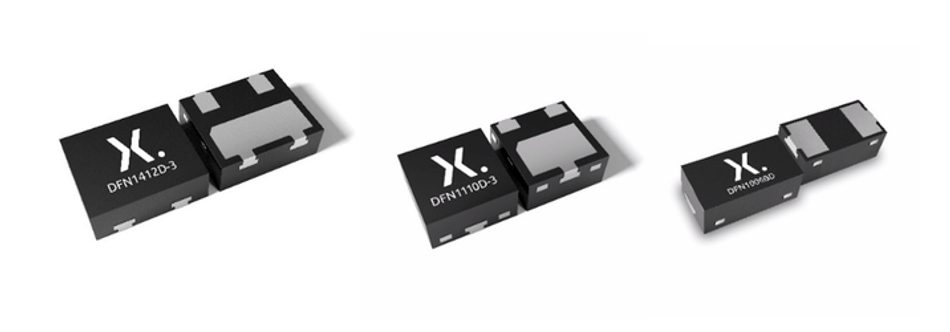
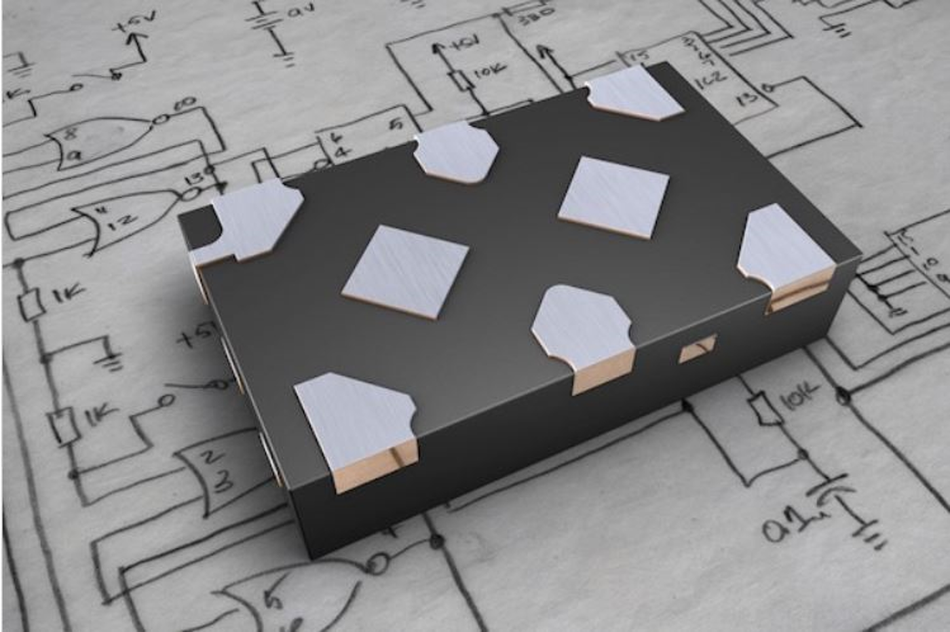
High Performing Discrete Semiconductor Components For 5G Applications In Vehicles.
The main applications for Discretes in a V2X modules are:
Power Supply
- Low RDS(on)1 MOSFETs for power conversion and reverse polarity protection.
- Low reverse current leakage (IR) Schottky Diodes for power conversion.
- Low forward voltage (VF) Schottky Diodes for OR-Ing and reverse battery protection.
- Low VCEsat transistors for Low-dropout regulators (LDOs)
Interfaces
- Analog switches for switching high-speed interfaces and/or sensors inputs.
- ESD protection to protect transceivers for CAN (FD), LIN, FLEX or automotive ethernet.
- Resistor Equipped Transistors (RETs), logic gates and buffers for signal conditioning.
Microcontroller Unit (MCU) interfaces
- Level shifters for signal translating across voltage levels between various ICs.
- Standard Logic Gates, multiplexers for I/O expansion.
Small Signal Diodes, Transistors and MOSFETs for various application.
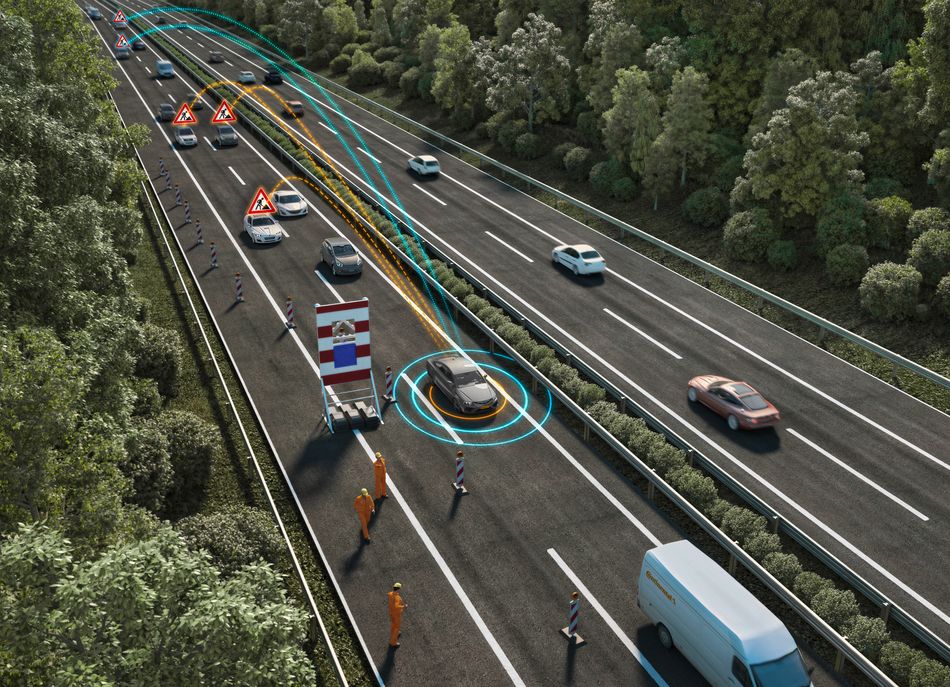
3 Use Cases of Discrete Semiconductor Components in V2X Applications
Use Case 1: Bipolar transistors and RETs to switch loads on/off
For the power management of a vehicle, the power consumption of the V2X module is critical. Within the module switching on/off loads needs to be done by being supplied of the lower voltage rails within the module itself. For example, the Wireless LAN in a car could be switched on or off.
Typical the required currents are less than 100mA. In addition, the Discretes should have a small form factor in such space constraint solutions. Bipolar transistors, resistor-equipped transistors (RETs, are used for such load switch on/off applications. The RETs and an increasing amount of double RETs come in small automotive qualified DFN packages with side-wettable flanks.
Use Case 2: Low RDS(on) N-Channel MOSFETs for power conversion and reverse battery protection
The V2X module in a car needs to be supplied with a specific voltage, e.g. 3.3V which is usually done via a discrete DC/DC step down converter. Here the efficiency of the MOSFET is key. In the power supply design, one of the first choices to make is to choose between an asynchronous or synchronous conversion architecture.
An asynchronous architecture would use a N-Channel Power MOSFET in combination with a low forward voltage Schottky Diode (Figure 5) while the synchronous architecture would use a second MOSFET instead of the Schottky Diode (Figure 6).
The later one would offer increased efficiency, due to a lower forward voltage drop of the MOSFETs versus the Schottky diode, to be considered as a tradeoff with the higher price of the MOSFET.
For such a switching application, the used MOSFET should have a low inductance and low resistance. Therefore, high performance switching silicon in a copper clip-bond package – like LFPAK (Loss-Free Package) - is recommended to use. If a small package in a 3x3 footprint is required, the LFPAK33 offers lowest resistance and best thermal performance.

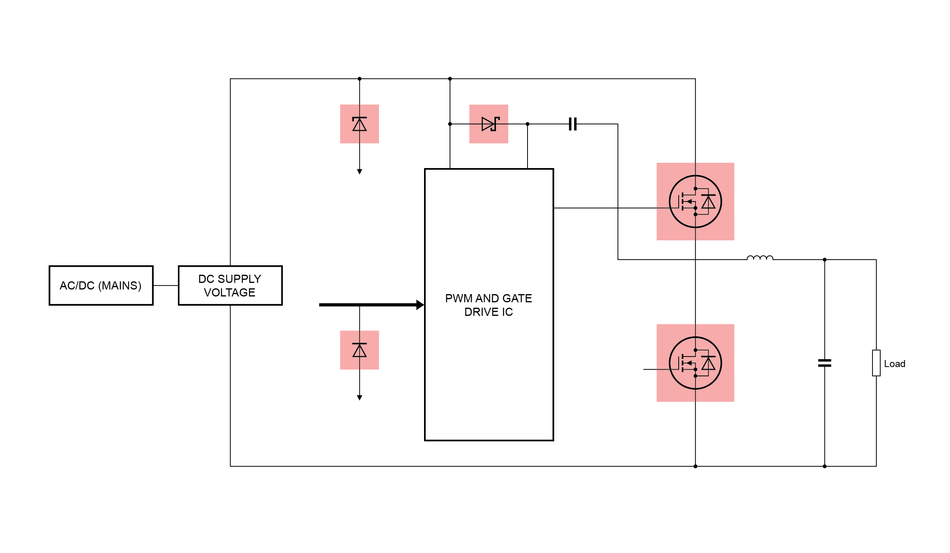
In case an asynchronous conversion is chosen, the Schottky diode should have lowest forward voltage for a certain power rating. Also, Schottky Diodes copper clip-bond packages are available, e.g. in the CFP package series (Clip-Bond Flat Power).
The reverse battery protection MOSFET should be able to sustain high currents in case of an unwanted current direction and also have low RDS(on) for normal operations. The recommendation would be to choose a MOSFET in LFPAK56, 40V and >100A current capabilities.
Use Case 3: External Electrostatic Discharge (ESD) protection devices for CAN (FD)
To communicate with the internal networking topology of the car, the V2X module features in-vehicle networking interfaces like CAN (FD). Modern MCUs, like the ones used in V2X modules, sometimes include the transceiver functionality, which directly exposes, the sensitive MCU to the harsh electromagnetic conditions of the wiring harness of the car.
The cost-efficient solution to guarantee the desired robustness against electrostatic discharges (ESD) is to use external ESD protection devices. As ESD robustness requires physical space in the silicon, a dedicated external device is often more reasonable than a much larger MCU crystal. Furthermore, external ESD protection additionally protects passive devices in the signal line preventing degradation at ESD events. Semiconductor manufacturers recently launched dedicated ESD protection devices for CAN FD.

Conclusion
Many of the major players in the automotive and telecom industry are investing in V2X and 5G technology and infrastructure. This in turn will enable applications in automotive like overtaking-assistance, smart traffic jam, or vulnerable road user warnings which would increase safety in traffic. Those safety features will need highly reliable V2X modules empowered by efficient devices with highest quality and performance.
Lastly, V2X Connected Cars coincide with two other major trends that are impacting automotive engineering: Electrification, and automation (from ADAS to high levels of autonomy). These three developments together put significant demands on the performance of semiconductors, whether they are discretes, logic or analog ICs, or more integrated components. For engineers knowing the characteristics of available components and their impact on a system’s performance will continue to increase in importance.
Notes:
1. RDS(on) = “drain-source on resistance,” or the total resistance between the drain and source in a Metal Oxide Field Effect Transistor (MOSFET) when it is “on.”12
2. Clip-bond packages have improved parameters like leakage current and heat dissipation compared to the traditional wired bonding used in semiconductor packaging. In A clip-bond package a clip on the top side pushes onto the die while the bottom face is connected to the package. The wide clip has a low resistance, low inductance and a wide area of contact for low thermal or heat dissipation.[13][14]
Sources:
1 5gaa.org/news/5gaa-live-demos-show-c-v2x-as-a-market-reality/
2 www.telekom.com/en/company/details/how-cars-should-talk-5g-versus-wifi-575026
4 www.ericsson.com/en/news/2019/9/5g-and-v2x
7 www.greencarcongress.com/2019/02/20190223-conti.html
9 www.gsma.com/futurenetworks/wiki/5g-implementation-guidelines/
10 www.digikey.com/en/articles/techzone/2016/mar/how-5g-will-change-the-industrial-internet-of-things
12 www.microcontrollertips.com/mosfets-what-is-rdson-faq/
13 chipsnwafers.electronicsforu.com/2015/05/25/clip-bond-technology-for-automotive-power-solution/
